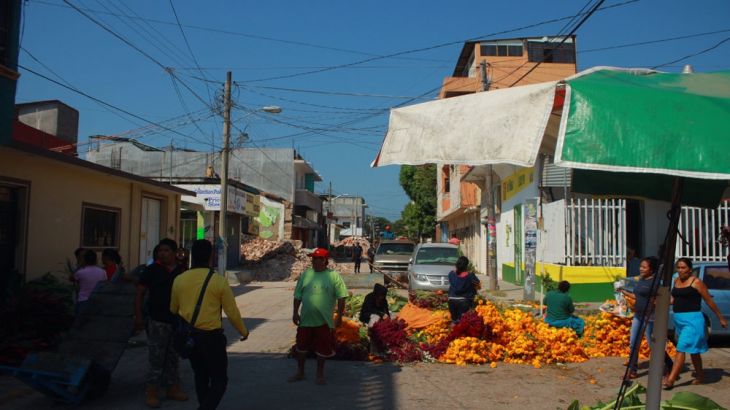Day of the Dead: Juchitan remembers earthquake victims
Residents of southern Mexican city say tradition takes on a new meaning after September’s deadly tremor.

Juchitan, Mexico – The only room left standing in Mariano Lopez’s home after last month’s deadly earthquake in southern Mexico was a small bedroom.
Lopez and his wife, Isabel Jimenez, have since had to move in with relatives, but over the last few weeks, have visited their Juchitan home to turn the remaining corner into a “biguie'” or an altar for Jimenez’s mother, Guillermina, who died in March.
Keep reading
list of 4 itemsHow Taiwan learned from the past to reduce the risk from earthquakes
How is Afghanistan coping six months after deadly quakes?
‘Violent rumble’: 4.8 magnitude earthquake rattles New York City, northeast
“The earthquake took our house, but it didn’t take away the happiness we get from receiving visits from our dead, and from this tradition that lives in our hearts,” Lopez told Al Jazeera.
Juchitan is known for its Day of the Dead celebrations. In any other year, the streets of the city centre are crammed with vendors selling the yellow cempasuchil (Marigold) flowers and fruits that are used in the rituals. This year, the celebrations are much more modest.
In the indigenous Zapotec language, which is spoken by most in the city, the traditions surrounding Day of the Dead are called Xandu, a Zapotec adaptation of the Spanish “Todos Santos” (“All Saints Day”).
But Juchitan was hit hard by the 8.2-magnitude earthquake that shook southern Mexico on September 7, meaning the celebrations have taken on a new meaning.
‘Juchitan has completely changed’
At least 37 people were killed in the massive tremor, and one out of three homes were left uninhabitable in the city of 75,000.
“Juchitan has completely changed, the dynamic of community life and social life has been cut off,” Gaspar Cabrera Manuel, a Catholic missionary who works in Juchitan, told Al Jazeera.
“People are focused on rebuilding their own houses and their own lives, and they’ve had to put other things aside,” he said.
Thousands still live under tarps, with relatives or in government shelters. Demolition of damaged houses has only just started, and reconstruction is still a long way off.
![The September 7 earthquake destroyed thousands of structures across southern Mexico [Edgard Garrido/Reuters]](/wp-content/uploads/2017/10/f77a02446e6e448f8f3a560724af5045_18.jpeg)
The federal government has begun handing out payments of 120,000 pesos (around $6,300) to people who lost their houses, but that amount of money is small compared with the value of the destroyed homes.
Oscar de Lima, a resident of Juchitan who organised the Xhie Nee Brigade to perform rescue and reconstruction work after the earthquake, told Al Jazeera that the quake has created a “psychological wound” in the people of Juchitan.
“Some of these houses had generations of hard work and investment put into them,” he said. “And now, people are realising that they’ve lost everything.”
The biguie’
But even in such a difficult situation, the people of Juchitan are keeping alive their pre-Colombian and syncretic Catholic traditions surrounding the Day of the Dead.
Almost every house in Juchitan was damaged by the quake, and the air is still filled with dust from demolitions. But people can be seen carrying bales of cempasuchil flowers back to their houses – or the lots where their houses once were – to build biguie’s.
The biguie’, the centre of the Xandu rituals, is a shrine that people build in their homes to welcome the dead, who, according to Zapotec tradition, visit their loved ones’ homes on October 30 and 31.
Biguie’ are elaborate structures, consisting of hanging wooden boards decorated with cempasuchil flowers and arrangements of photographs and fruits or snacks preferred by the deceased relative.
Building a biguie’ implies a significant investment of time and money that many in Juchitan are struggling to make this year, so many offerings are much smaller than normal.
But creating an offering for the dead, even a modest one, is still a priority for many.
“The dead come only once a year, so you have to welcome them,” said Cabrera Manuel, the Catholic missionary.
“Even if it’s just a small altar, a seat on the patio. There’s a very strong, intense emotional connection, and it can’t be broken, not even by an earthquake.”
![Mariano Lopez and Isabel Jimenez built a biguie' for Jimenez's mother who passed away this year [Simon Schatzberg/Al Jazeera]](/wp-content/uploads/2017/10/77a77e42f9744e5080a22826b3347303_18.jpeg)
For Lopez and Jimenez, this year’s biguie’ is especially important, partly because many people in Juchitan will not be able to participate in the tradition. They hope Jimenez’ mother’s biguie’ will offer refuge to spirits of the dead whose families are prevented from building offerings.
“This year we are celebrating my mother Guillermina, but it’s not just about her, because she can share it with the others,” Jimenez said.
“The people who died on the streets, the people with no family, the people with nowhere to go to receive the smell of fruits and flowers, it’s also for them, they’re also welcome here.”
The biguie’ is an important tradition that Zapotec people are working to keep alive, but for Lopez, Xandu represents something deeper than any specific material ritual.
“When I feel the strong October breeze, carrying the smell of the cempasuchil and incense, it’s already Todo Santo for me,” he said. “When the winds blow against our bodies, our ears, our hair and our faces, that’s the spirits caressing us, reminding us that we are not alone, and bringing us nostalgia and happiness.”
And like for many others, the Xandu traditions bring Lopez and Jimenez comfort in a situation of extreme adversity.
“It helps us rebuild our souls, our way of thinking and our way of life.”